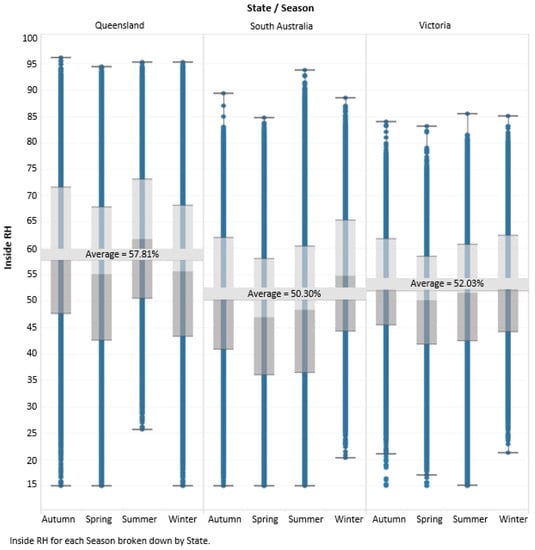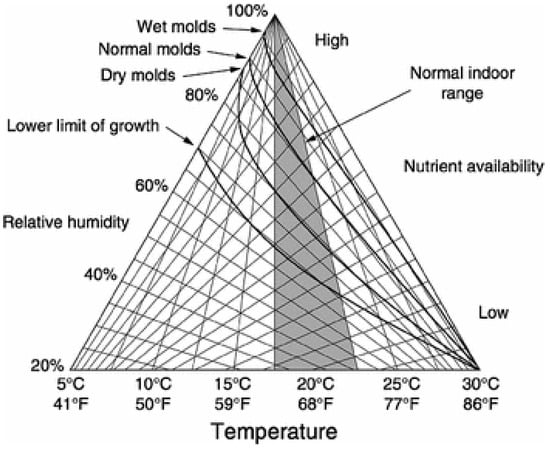Your browser does not fully support modern features. Please upgrade for a smoother experience.
Please note this is a comparison between Version 1 by Shruti Nath and Version 4 by Dean Liu.
The external wall’s moisture accumulation and mould growth were simulated for a period of ten years using the transient hygrothermal simulation tool, WUFI® Pro, and the mould growth model, WUFI® VTT.
- energy efficiency
- condensation
- hygrothermal
- mould growth
1. Condensation and Mould Problem in Homes
Due to much cooler winter conditions, other developed nations, including the United States, Canada, Japan, the United Kingdom, and Germany, have established a co-relationship between better envelope design and hygrothermal design since the 1990s, as these countries encountered condensation and mould problems in buildings at earlier times [1][2][3][4][5][8,9,10,11,12]. However, many countries in temperate and warmer climates have not needed to consider building envelope related condensation and mould matters until the last decade, when insulation and air-tightness measures have been introduced in response to energy efficiency regulations. Mould growth involves five of the following conditions: infestation, i.e., germination of mould spores; nutrients (mainly cellulose and starch, but also dirt and dust); temperature (in the range of 0–50 °C); moisture (surface relative humidity of above 65%); and oxygen [5][6][7][8][9][10][11][12,13,14,15,16,17,18]. Figure 1 shows the various conducive conditions for mould growth.
According to the Australian Occupational Health and Safety (OH&S) guidelines (July 2011), the recommended range of interior relative humidity is 30–60% [13][20]. This range of relative humidity was adopted from the Canadian CSA Standard CAN/CSA Z412-00 (R2005)—"Office Ergonomics” which refers to ASHRAE 55 (2010) [13][20]. Research conducted by Dewsbury at the University of Tasmania documented a considerable quantity of interior relative humidity values recorded above 95% in subfloor zones and 85% in living room zones, with regular instances of surface and interstitial condensation and mould in Tasmanian homes [14][21]. The CSIRO’s national Indoor Air Study, which collected data regarding the temperatures within code-compliant housing, also collected relative humidity data [15][22]. Figure 2 shows the measured indoor relative humidity data that has been collected by the CSIRO. The data shows the indoor relative humidity for one calendar year, from houses in Queensland, South Australia, and Victoria [16][23]. The data shows that houses from different Australian states, with distinctly different climate zones, in different seasons have recorded interior relative humidity values above 75%, which may be providing conducive environments for mould growth.

In Australia’s temperate and cool-temperate climates, the external air temperature is less than 20 °C for between 50 and 92% of the hours in a calendar year. The focus in southern Australia has been to make houses warmer in winter [17][24]. With these insulated and more airtight new homes, with warmer interior conditions, design and construction professionals, and inhabitants, are reporting increased incidents of condensation and mould during the cooler months (April–October) in all eight Australian legislative jurisdictions [5][18][12,25]. This is a significant issue, as moisture and/or mould in the built fabric lead to building degradation and substantive impacts on human health [14][19][20][21][21,26,27,28].
Whilst this is a present issue for Australia, countries like New Zealand, which is cooler than most of Australia, had their crisis two decades ago [22][29]. Meanwhile, other warmer and less developed countries will have their own building condensation and mould-related crises in the coming decades. Those cooler countries that have developed standards and guidelines have made changes to insulation and airtightness in their built fabric since the late 20th century for human health reasons and have retrospectively worked towards hygrothermal simulation to solve the problems of condensation and mould in building envelopes and building interiors. Due to Australia’s post-1998 focus on reducing greenhouse gas emissions, the first, and somewhat simplistic, energy-efficient building envelope regulations were not applied in Australia until 2003.
As these insulation requirements have increased, it is only in the last decade that concerns have been raised regarding condensation and mould in new housing. Sadly, many uninsulated older houses also have mould problems, but this is often accepted as ‘normal’. At the 2021 International Conference on Moisture in Buildings, Kuenzel and Dewsbury [23][30] identified the international need for complex transient hygrothermal simulations to inform building envelope design.
2. Impact of Condensation Problems and Mould Growth on Occupant Health
Several international studies have recognized links between condensation, mould, and human health. The most detailed study was done by the World Health Organisation—Europe, which established:
“Sufficient epidemiological evidence is available from studies conducted in different countries and under different climatic conditions to show that the occupants of damp or mouldy buildings, both houses, and public buildings, are at increased risk of respiratory symptoms, respiratory infections and exacerbation of asthma”
Architectural science research has identified that Australia has twice the asthma rate of other OECD countries [24][25][26][27][31,32,33,34]. Asthma is a prominent illness in children aged 0–14 years in Australia, accounting for 12.3% of the total asthma burden [28][35]. There is ample proof from the discipline of medical science that mould spores are associated with several immunology and allergy conditions that may cause lifelong illnesses [29][30][31][32][36,37,38,39]. Within this context, if the built fabric of new energy-efficient homes is a cause of moisture and mould in new homes, then the design and construction professions need adequate guidance regarding the make-up of envelope systems or methods by which to ascertain whether an envelope system is truly climatically appropriate.
It has been estimated that the proportion of buildings affected by mould is 45% in Europe, 40% in the USA, 30% in Canada, and up to 50% in Australia, emphasising the significance of this problem [33][40]. Forty percent of respondents to a 2016 Australian national design and construction industry survey identified condensation and mould issues within stand-alone housing and multi-residential buildings constructed between 2006 and 2016 [14][21]. Since 2016, there have been several reported cases of condensation and mould problems in contemporary homes in different legislative jurisdictions across Australia [14][34][35][36][37][38][39][21,41,42,43,44,45,46]. However, to date, there has been no comprehensive investigation regarding the results of the national survey or a deep economic analysis regarding the costs associated with building rectification or impacts on human health.
In Australia, while it is acknowledged that housing affects health [40][47], housing and health are challengingly governed in different portfolios of government. By comparison, the European Union, the United States of America, Canada, the United Kingdom, and New Zealand have accepted the necessity for interrelated regulatory development between public health regulations and inter-related occupant health requirements within their national building regulations. The first inclusion of clauses requiring the minimisation of condensation and mould within the Australian building regulations occurred in 2019, and this has placed “Australia behind the eight ball on healthy housing” [41][48]. The new regulations only apply to residential buildings. The newly published regulations for 2022, to be enacted in 2023, still only require action in new residential buildings. Whereas the 2019 regulations focused on condensation [42][1], the 2022 regulations, which were informed by this research, have included references to the Mould Index [6][13]. It is hoped that non-residential buildings will be included by 2025. Compounding this, many elderly people, people with health problems, and children spend up to 90% of their time indoors [43][49]. Furthermore, the COVID-19 pandemic, which caused people to spend more time indoors, has created an urgent situation in which housing and health must be considered together more intentionally [44][45][50,51].
3. Key Focus Study Area
The research discussed in this article forms part of broader research activities that are exploring the hygrothermal considerations that need to be considered for the pathway to net zero housing in Australia. ResearchersThis article discusseds the hygrothermal and mould growth computer simulation methods that were developed and applied, which are innovative within the Australian context [46][47][52,53]. ReThis serchers tudy has a significant national impact, establisheding and informeding hygrothermal analysis methods for residential wall systems within warm temperate, temperate, and cool temperate climates in Australia.
From 2008 to 2016, the University of Tasmania architectural science researchers liaised with the Tasmanian State government, the Australian Commonwealth Scientific and Industrial Research Organisation (CSIRO), the Australian Building Codes Board (ABCB), and industry-based collaborators regarding the urgent need to develop hygrothermal (condensation and mould) related guidance and regulation for the design and construction professions. Since 2014, the non-transient calculation methods have been used in Australia and have identified significant knowledge, practice, and regulatory gaps [5][14][18][48][12,21,25,54]. Non-regulatory adoption of transient hygrothermal simulation software was introduced in 2017. Specifically, this article discusses the detailed hygrothermal and mould growth computer-based simulation to explore moisture accumulation and mould growth risks associated with a clay masonry veneer low-rise residential external wall system. The analysis of the wall system explores the implications of insulation and air-tightness requirements expected for a 7-star regulatory compliant wall system in 2022. ReThisearches study required the assessment of hygrothermal calculation methods, their inputs and outputs, and how the method and simulation results could inform building regulatory development. Due to the correlation between mould and several human health impacts and the regulatory lever regarding healthy building interiors, researchers this study included methods of mould growth simulation. The hygrothermal and mould growth simulation results of a typical clay masonry veneer wall system in a cool temperate climate have been published earlier [46][47][52,53]. This article focuses on the results from the timber-framed clay masonry veneer wall system, simulated within the Cfb Köppen-Geiger classified oceanic temperate climate of Melbourne, Australia. The timber-framed clay masonry veneer wall system represents approximately 50% of new stand-alone low-rise residential buildings in Australia. The results of the other residential wall systems in different selected Australian climates will be reported in future articles.

